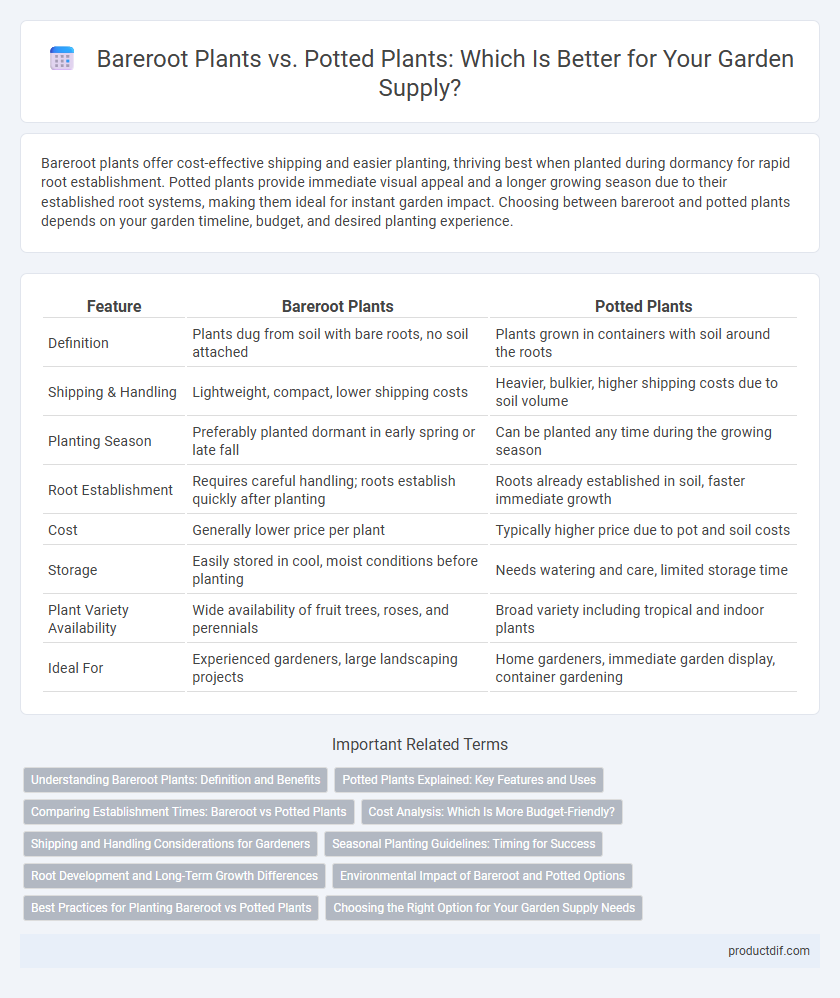Bareroot plants offer cost-effective shipping and easier planting, thriving best when planted during dormancy for rapid root establishment. Potted plants provide immediate visual appeal and a longer growing season due to their established root systems, making them ideal for instant garden impact. Choosing between bareroot and potted plants depends on your garden timeline, budget, and desired planting experience.
Table of Comparison
| Feature | Bareroot Plants | Potted Plants |
|---|---|---|
| Definition | Plants dug from soil with bare roots, no soil attached | Plants grown in containers with soil around the roots |
| Shipping & Handling | Lightweight, compact, lower shipping costs | Heavier, bulkier, higher shipping costs due to soil volume |
| Planting Season | Preferably planted dormant in early spring or late fall | Can be planted any time during the growing season |
| Root Establishment | Requires careful handling; roots establish quickly after planting | Roots already established in soil, faster immediate growth |
| Cost | Generally lower price per plant | Typically higher price due to pot and soil costs |
| Storage | Easily stored in cool, moist conditions before planting | Needs watering and care, limited storage time |
| Plant Variety Availability | Wide availability of fruit trees, roses, and perennials | Broad variety including tropical and indoor plants |
| Ideal For | Experienced gardeners, large landscaping projects | Home gardeners, immediate garden display, container gardening |
Understanding Bareroot Plants: Definition and Benefits
Bareroot plants are dormant plants sold without soil, with their roots exposed and carefully wrapped to retain moisture. These plants establish stronger root systems faster than potted plants because the roots grow directly into the garden soil without transplant shock. Benefits include lower cost, easier storage and transport, and the ability to plant larger specimens that promote vigorous growth.
Potted Plants Explained: Key Features and Uses
Potted plants come in containers filled with soil or growing media, providing immediate root support and hydration, making them ideal for instant landscaping or indoor decoration. Their established root systems allow for easy transplanting with minimal shock compared to bareroot plants, supporting healthier growth in various garden settings. Commonly used for annuals, perennials, and small trees, potted plants offer versatility and convenience for both novice and experienced gardeners.
Comparing Establishment Times: Bareroot vs Potted Plants
Bareroot plants typically establish faster than potted plants due to their unhindered root growth once planted, allowing quicker adaptation to new soil conditions. Potted plants often experience root circling or restriction, which can delay root expansion and establishment in the garden. Choosing bareroot plants can lead to more rapid growth and earlier flowering or fruiting compared to their potted counterparts.
Cost Analysis: Which Is More Budget-Friendly?
Bareroot plants generally offer a more budget-friendly option compared to potted plants due to lower shipping and packaging costs, often priced 20-50% less. While bareroot plants require more initial care and careful planting to establish, their reduced upfront cost makes them ideal for large-scale garden projects or budget-conscious gardeners. Potted plants, though more expensive, provide immediate growth and display, potentially saving costs on replacement if bareroot plants fail to thrive.
Shipping and Handling Considerations for Gardeners
Bareroot plants require careful shipping during their dormant season to prevent root drying and damage, often arriving bundled with moist packing materials that ensure moisture retention. Potted plants, shipped with soil and containers, are heavier and more susceptible to damage from jostling but offer the advantage of immediate planting without the need for soaking or pruning. Gardeners should consider shipping times, packaging quality, and humidity controls to maintain plant health and vitality upon arrival.
Seasonal Planting Guidelines: Timing for Success
Bareroot plants thrive when planted during their dormant season, typically late fall to early spring, allowing roots to establish before active growth. Potted plants offer more flexibility and can be planted throughout the growing season but perform best when placed in early spring or fall to avoid heat stress. Following these seasonal planting guidelines enhances root development and increases the chances of healthy, vigorous growth in any garden setting.
Root Development and Long-Term Growth Differences
Bareroot plants typically exhibit more vigorous root development due to their exposure during dormancy, allowing them to establish stronger, deeper root systems once planted. In contrast, potted plants often experience root confinement and potential circling, which can limit long-term root expansion and overall plant growth. The enhanced root establishment in bareroot plants supports better nutrient uptake and sustainability, contributing to improved long-term garden performance.
Environmental Impact of Bareroot and Potted Options
Bareroot plants typically have a lower environmental impact due to reduced packaging and lighter transportation weight, which decreases fuel consumption and carbon emissions during shipping. Potted plants often require plastic pots, frequent watering during transit, and more energy-intensive handling, contributing to higher waste and resource use. Choosing bareroot plants supports sustainability by minimizing plastic waste and transportation-related environmental costs.
Best Practices for Planting Bareroot vs Potted Plants
Planting bareroot plants requires soaking roots several hours before planting and ensuring roots are spread evenly in a wide hole filled with loose, nutrient-rich soil to promote root expansion. Potted plants benefit from gently removing the container to loosen root balls and planting at soil level to avoid stem burial, with consistent watering to reduce transplant shock. Mulching around both types aids moisture retention and temperature regulation for optimal establishment and growth.
Choosing the Right Option for Your Garden Supply Needs
Bareroot plants, sold dormant without soil, offer a cost-effective and space-saving option ideal for early spring planting and shipping. Potted plants provide instant greenery with established root systems, ensuring faster growth and less transplant shock suitable for year-round gardening. Selecting between bareroot and potted plants depends on your planting season, budget, and desired growth speed for optimal garden supply management.
Bareroot Plants vs Potted Plants Infographic

 productdif.com
productdif.com